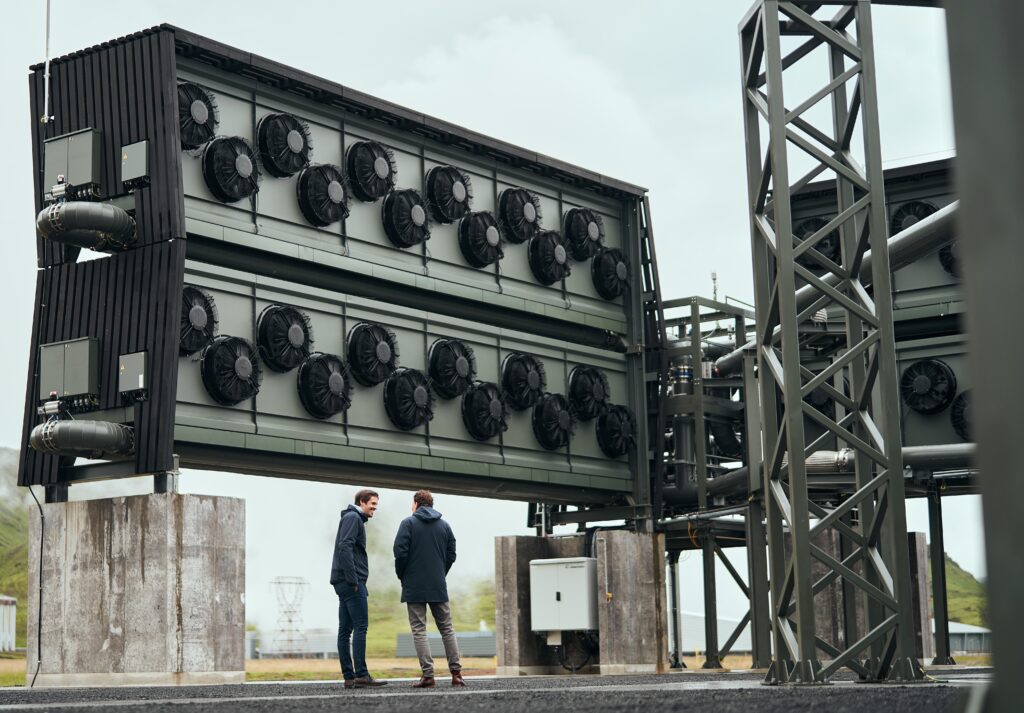Orca, the world’s largest direct air capture and CO2 storage plant, starts operations

Today (8th Sept.2021) Climeworks begins operations at Orca, the world’s first and largest climate-positive direct air capture and storage plant, making direct air capture and storage a reality.
Shortly after the IPCC stated a clear and urgent need for carbon dioxide removal, the inauguration of Orca provides immediate impact: every ton of carbon dioxide removed from the air by Orca is a ton immediately not contributing to global warming.
Orca represents a milestone in the direct air capture industry with its capacity of capturing 4’000 tons of CO2 per year, which will be removed from the air safely and stored permanently through the Carbfix natural mineralization process.
The plant is a steppingstone for Climeworks’ expansion on route to megaton removal capacity by the second part of this decade, based on our leading and most scalable direct air capture technology.
Orca delivers permanent, metered carbon dioxide removal and sets the precedent for a high-quality, verifiable carbon removal market by being the first direct air capture and storage service with a validated process – awarded mid-June 2021 by independent third-party DNV.
Unprecedented extreme weather events have dominated the news headlines since early this year. The United Nation’s Intergovernmental Panel on Climate Change cautions that the world will see more of this in years to come. The report further confirms that it is crucial to reduce our emissions drastically and remove unavoidable and historic carbon dioxide emissions from the air permanently.
One month after the report was published, Climeworks launches Orca, the world’s largest direct air capture and storage plant that permanently removes CO2 from the air.
Orca at a glance
The construction of Orca started in May 2020 and is based on advanced modular technology in the form of innovative stackable container-size collector units. These units are powerful and compact with minimal physical footprint. This has made it possible for Orca to be operational in under 15 months. Compared to the previous technology generation, the use of steel in the collector units has been reduced by roughly half per output unit. Orca also supports the expansion of Climeworks, as the technology can easily be replicated at different locations worldwide and on ever larger scales, in a flexible manner wherever ample renewable energy and storage conditions are available. Strategically located adjacent to ON Power’s Hellisheiði Geothermal Power Plant, Orca runs fully on renewable energy.
Orca is the first-of-its kind plant that translates the vision of industrial-scale direct air capture and storage into reality. This improved technology generation comes in an award-winning new design, which embodies the interconnection between nature and technology. For the technology generation which Orca represents, Climeworks has been able to intensify the process leading to increased CO2 capture capacity per module. This optimized process means that more carbon dioxide can be captured and stored than ever before.
Expansion is around the corner
This innovation in plant design is a key enabler to rapidly scale up this much-needed climate technology in the years to come. Since Orca is now a reality and in operation, Climeworks is on track to ramp up its capture capacity significantly – as will be required in light of the strong market demand as shown through long-term partnerships with, among others, Microsoft, Swiss Re, Shopify and commitments from over 8’000 private individuals. Climeworks inspires and supports more pioneering companies and individuals to act now and remove carbon dioxide from the air.
Partnership with Carbfix and ON Power
Strong partnerships with pioneering Icelandic companies support the excellent conditions for the scale up. ON Power, the Icelandic geothermal energy provider, supplies clean renewable energy to power the Orca plant. Our partners Carbfix, experts in rapid underground mineralization mix the air-captured CO2 with water and pump it deep underground, where it is trapped in stone through a natural mineralization process that takes under two years.





